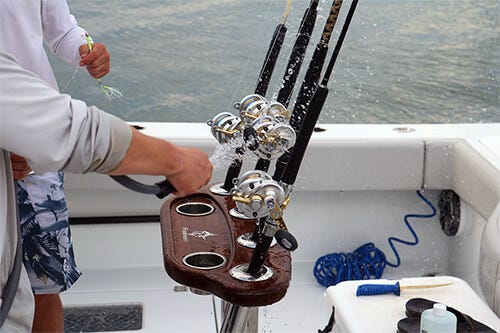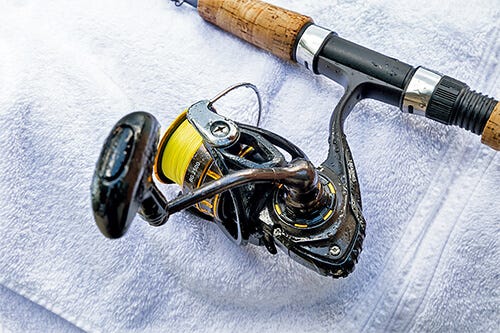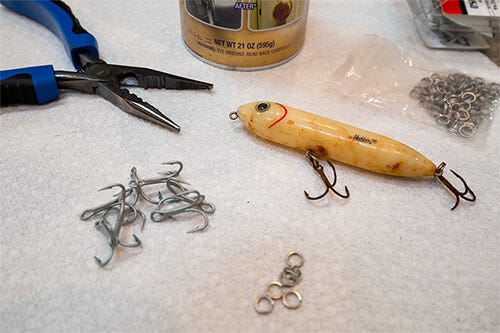

There’s just something awful about the look of rust. Whether it’s on a hook, a pair of pliers, or some other piece of tackle or equipment, rust destroys both form and function of anything it gets ahold of. For freshwater fishermen, rust avoidance can be a simple matter of proper maintenance routines, but for saltwater fishermen, much more thought and effort are required to keep rust at bay. Here are some tips for preventing rust on your fishing tackle and tools and for addressing it when it does occur.
What Causes Rust: Three Key Ingredients
The first step to solving a problem is to fully understand it, and while most people know what rust is on a general level, breaking it down further provides clear direction about how to avoid it. Rust is a chemical reaction, and like all chemical reactions, it requires specific ingredients to occur and other ingredients to be accelerated. Reducing or removing these ingredients from the equation will impede or eliminate the chemical reaction.
For our purposes, there are three required ingredients for rust, plus a fourth ingredient that expedites the process. The required ingredients are iron (or iron alloys), oxygen, and water. Add chloride (salt) to the equation, and you accelerate the reaction. Eliminating or reducing any of these ingredients will slow down or eliminate the rusting process.
Preventing Rust by Removing the Ingredients
When you approach the goal of avoiding rust by focusing on its causes, the traditional solutions you may be familiar with make more sense and you can apply them in a more targeted manner to maximize their impact. Consider how each rust-prevention solution impacts each of the ingredients of the chemical reaction.
Eliminating Iron
If you primarily fish in saltwater, the best solution to avoiding rust is simply to avoid equipment and tackle that contains (exposed) iron. Most saltwater lures come with nickel-plated hooks that are resistant to rust. Swap out the cheap steel pliers for the more expensive — but corrosion resistant — aluminum ones.
If you primarily fish in saltwater, the best solution to avoiding rust is simply to avoid equipment and tackle that contains (exposed) iron.
Look for stainless steel or aluminum tools and equipment. The cost of non-iron-based equipment will be higher up front, but it will last longer, work better, and avoid staining your boat, tackle box, and storage areas.
Removing Salt
Rinsing lures, tackle, and equipment after a saltwater fishing trip is only beneficial in reducing or eliminating the chloride (salt) ingredient. Remember, salt is simply an accelerator of the process. In reality, by rinsing your equipment, you are simply diluting or washing away the chloride accelerant; as long as the three required ingredients — water, iron, and oxygen — are still present, rust can still form.
A number of commercially available products claim to “dissolve” or “neutralize” salt. In fact, nothing dissolves salt better than warm, fresh water. In the real world, though, there’s more than just salt on your tackle after a day of saltwater fishing, and products like Salt-Away are good at essentially helping the water do its job. They contain surfactants that cut oil, grease and other substances that can repel water, keeping it from reaching salt deposits. They also contain acids that dissolve calcium deposits from seawater.
Limiting Water
Rinsing your equipment may remove the salt, but keep in mind that you are also introducing more of one of the required ingredients: water. This is why drying your equipment after you rinse it is an equally critical step.
Drying your equipment after you rinse it is an equally critical step.
Drying the equipment reduces one of the required ingredients. When you rinse and dry your equipment you have both limited the accelerator (salt/chloride) and limited the primary ingredient, water.
Eliminating Water
Drying your equipment only limits water, rather than eliminating it. Invisible water vapor — and if you are on the coast, saltwater vapor — remains in the equation. To eliminate or limit water vapor, you have to keep these airborne ingredients away from your equipment. How? If possible, simply move your equipment into an air-conditioned room. This will dramatically reduce the amount of moisture in the air. Equipment left in your garage or an outdoor shed will rust much more quickly than equipment stored in a climate-controlled space. You can also use moisture absorbing items such as charcoal, silica packs, and rice to absorb the moisture in the air around your tackle and equipment.
Limiting Oxygen
Eliminating or limiting moisture and salt are the simplest solutions to avoiding rust, but you have one more arrow in your quiver: limiting exposure to oxygen. This generally requires a coating for your equipment with something that creates a barrier between the equipment and the air. Oil, solvents, and other corrosion inhibitors like the popular Boeshield T-9 can be applied to your equipment to create a barrier.
Oils, solvents, and other corrosion inhibitors can be applied to your equipment to create an oxygen barrier.
Keep in mind that some of these coatings will transfer to clothing, boat decks, or other surfaces, causing stains and potentially slippery surfaces, so use these sparingly and wipe away any residue with a clean rag. Also be aware that using these on tackle may have undesirable impacts on your catch rate!
Getting Rid of Rust on Fishing Tackle and Tools
Avoiding rust in the first place is always the best solution, but sometimes life happens. The metal hooks on a favorite, heavily used lure will eventually succumb to surface rust, even if they were originally coated or plated with rust resistant alloys. Springs or other components hidden within your equipment may be made of iron-alloys, and will eventually show signs of oxidation.
When these things happen, time is of the essence. The more quickly rust is addressed, the easier it is to control. For lures, simply replace the hooks when they show signs of rust. This is a good idea anyway to keep the hooks sharp and strong, and a pair of split ring pliers makes this a 30-second job. For equipment, WD-40 and a toothbrush goes a long way to removing surface rust (a wire brush may be required for more serious situations).
Time is of the essence. The more quickly rust is addressed, the easier it is to control.
Other effective rust removers include acid-based cleaners like white vinegar or Barkeeper’s Friend. Simply make a paste with Barkeeper’s Friend and water, let it sit on the rusted metal for a few minutes, and wipe clean. When household solutions don’t get the job done, try a specialty rust remover like Rust Free. Once addressed, coating the equipment in a strong, flexible corrosion inhibitor, such as Boeshield T-9 will provide ongoing protection.
Even after addressing the rust, you will want to keep an eye on the equipment, as it is more prone to rust once the process has started. Plan to reapply the protective coating every few trips to say ahead of any moisture penetration.
Cleaning Up Rust Stains
Whether you have replaced a rusty hook or cleaned and coated a rusted area of fishing equipment, you may still be left with the ugly stains that rust leaves behind. The good news is that, for most surfaces, the orange stain can easily be removed. For boat decks, hatches, and compartments, Starbrite Rust Stain Remover works well. For tackle boxes, lures, and other plastics, using soap, lemon juice, and vinegar can quickly remove rust stains with minimal scrubbing.
Keeping Your Gear Rust-Free
Beyond its ugly orange hue, rust can significantly damage the functionality and strength of critical fishing equipment. Avoiding rust relies on a better understanding of the ingredients that work together to start the process, and then taking preventative steps to keep those ingredients away from your equipment.
Avoiding rust relies on a better understanding of the ingredients that work together to start the process.
Start by minimizing the use of iron-based equipment to avoid the problem entirely. Spending the extra money up front on aluminum or stainless-steel tools and equipment vastly simplifies your maintenance and cleaning time, and provides greater longevity and usefulness of the equipment over time.
For tackle and equipment that aren’t rust resistant, take preventative measures such as rinsing, drying, and storing the equipment in an air-conditioned room. And finally, if and when rust does rear its ugly head, address it quickly by either replacing the rusted component or cleaning and coating the equipment with a corrosion inhibitor.




